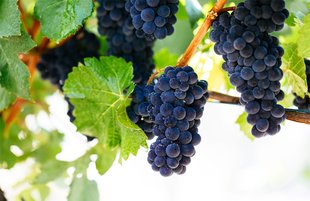Pinot Noir vs Cabernet Sauvignon: 6 Key Differences
Pinot Noir and Cabernet Sauvignon are two of the world’s most popular wines. While Pinot Noir wine stands out with its light and fruity character, Cabernet Sauvignon has a more overpowering and savory flavor profile.
So, should you go for a Pinot or Cabernet?
In this article, we’ll explore all the key differences between Pinot Noir and Cabernet Sauvignon, including their origins, grape characteristics, tasting notes, price, and more.
Further reading
- Explore the exciting world of Red Wine.
- Discover more about Cabernet Sauvignon wines in this guide.
- And dive into the delicious world of Pinot Noir.
Pinot Noir vs Cabernet Sauvignon: 6 Main Differences
Here are the key differences between Pinot Noir and Cabernet Sauvignon:
1. Origins

While Pinot Noir originates from the Burgundy wine region, Cabernet Sauvignon is native to Bordeaux. Both red wine grape varieties are grown worldwide, and they’re also quite popular in the Napa Valley wine region of California.
2. Grape Characteristics

Similar to Nebbiolo, the Pinot Noir grape is difficult to grow and maintain.
That’s because the Pinot Noir wine grape has very thin skin that can be easily damaged by heat. The thinner grape skins also lend lighter flavors and lower tannin levels to the wine.
Additionally, this red grape variety forms tight clusters, so disease and rot can spread quickly.
The Pinot Noir grape is highly versatile and is used to produce sparkling wine and even white wine.
On the other hand, the Cabernet Sauvignon grape has thick, durable skin (similarly to Petit Verdot.) As a result, the Cabernet Sauvignon grape variety is highly adaptable to different climates and regions.
Cabernet Sauvignon grapes also contain medium-to-high tannin levels, which is why Cabernet Sauvignon wines are bolder and drier.
3. Appearance, Aromas, And Tasting Notes

If you go for a Pinot Noir wine tasting, you’ll notice that this wine has a delicate, light red color.
The wine opens with a bouquet of silky, earthy, and fruity floral aromas. The palate offers red fruit and dark fruit flavors and a hint of earthy flavors. Pinot Noir wines usually have medium to high acidity and a long, lingering finish.
On the other hand, Cabernet Sauvignon wines present a mesmerizing, deep purple color (lighter than Petite Sirah and Zinfandel.)
Cabernet also offers alluring aromas of violets, black cherry, and hints of spice. The palate also reveals dark fruit, tobacco, and green bell pepper flavors. Generally, Cabernet Sauvignon wines have less acidity than Pinot Noir.
4. Sweetness

Both Pinot Noir and Cabernet Sauvignon are dry red wines with low residual sugar levels similar to Merlot and Petite Sirah wine.) However, Cabernet Sauvignon has higher tannin levels and tends to taste drier.
5. Pricing

Pinot Noir grapes have higher production costs due to their delicate skin. Wines like Burgundian Pinot Noir wine are generally more expensive than regular Cabernet Sauvignon bottles.
When it comes to Cabernet Sauvignon, Californian Cab is usually more expensive than its Bordeaux counterpart (usually a Cabernet Sauvignon blend with Cabernet Franc, Merlot, Petit Verdot, and Malbec.)
6. Food Pairings

The Pinot Noir varietal wine matches well with many different foods.
You can pair a glass of fruity Pinot Noir with pork, lamb, poultry, grilled salmon, and mushrooms.
On the other hand, a glass of dry red wine like Cabernet Sauvignon pairs perfectly with more savory foods like hamburgers, juicy steaks, and other red meat dishes.
Which Is Better: Pinot Noir Or Cabernet Sauvignon?

Here are some of the pros and cons of Pinot Noir and Cabernet Sauvignon:
Pros of Pinot Noir:
- Low-medium bodied
- Low tannins
- Higher acidity levels
- Considered the healthiest red wine
- Pairs well with both vegetable and meat dishes
Cons of Pinot Noir
- Difficult to grow
- Has a shorter shelf life (4-5 years)
Pros of Cabernet Sauvignon
- Excellent aging potential (10-20 years)
- A full-bodied varietal wine
- Rich taste
- Lower acidity levels
Cons of Cabernet
- Some Californian Cabernets are high-priced
- Doesn’t pair well with lighter dishes
In reality, it’s tough to choose between the two!
But, if you prefer a dry wine with delicate red fruit flavors, a delicious bottle of Pinot Noir should be your go-to.
However, for wine drinkers who love stronger wines with powerful tannin levels and dark fruit notes, then Cabernet Sauvignon wine is a great choice.
Add Your Favorite Red Wine To Your Collection
There are several differences between Pinot Noir and Cabernet Sauvignon. However, they are both undoubtedly delicious red wines.

And if you’re looking for fine red wine, white wine, or even dessert wine, check out the Vinovest website and discover how you can add them to your collection with ease.



